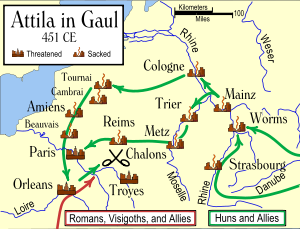Attila the Hun
2007 Schools Wikipedia Selection. Related subjects: Historical figures; Military People
| Attila the Hun | ||
|---|---|---|
| King of Huns | ||
| Reign | 434 – 453 | |
| Born | ~406 | |
| Died | 453 | |
| Predecessor | Bleda | |
| Successor | Ellac | |
Attila the Hun (405–453), also sometimes known with the nickname as Attila the Scourge of God (Flagellum Dei) or simply Attila was the most powerful king of the Huns.
He reigned over what was then Europe's largest empire, from 434 until his death. His empire stretched from Germany and the Netherlands to the Ural river and from the Danube River to Poland and Estonia. During his rule, he was among the most dire of the Western and Eastern Roman Empire's enemies: he invaded the Balkans twice and besieged Constantinople in the second invasion; he marched through Gaul (modern day France) as far as Orleans before being defeated at the Battle of Chalons; and he drove the western emperor Valentinian III from his capital at Ravenna in 452. He was regarded as sacker of cities.
Though his empire died with him and he left no amazing legend, he has become a legendary figure in the history of Europe. In much of Western Europe, he is remembered as the epitome of cruelty and rapacity. In contrast, some histories lionize him as a great and noble king, and he plays major roles in three Norse sagas.
Background
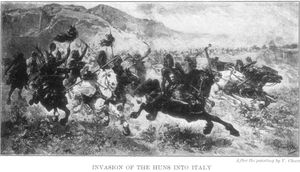
The origin of the European Huns has been the subject of debate for centuries; however, it can be said with general agreement that they were a confederation of Eurasian tribes, most likely of diverse origin with a Turkic-speaking aristocracy, who appeared in Europe in the 4th century. They achieved military superiority over their rivals (most of them highly cultured and civilized) by their readiness for combat, unusual mobility, and weapons like the Hun bow.
Nothing is known about Attila's youth except for the day he was born. He first appears in the historical record when he becomes joint king of the Huns with his brother Bleda.
Shared kingship
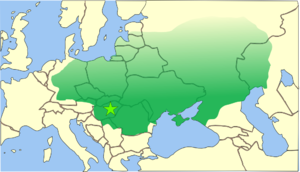
By 432, the Huns were united under Rugila. In 434, Rugila died, leaving his nephews Attila and Bleda, the sons of his brother Mundzuk, in control over all the united Hun tribes. At the time of their accession, the Huns were bargaining with Theodosius II's envoys over the return of several renegade tribes who had taken refuge within the Byzantine Empire. The following year, Attila and Bleda met with the imperial legation at Margus (present-day Požarevac) and, all seated on horseback in the Hunnic manner, negotiated a successful treaty: the Romans agreed not only to return the fugitive tribes (who had been a welcome aid against the Vandals), but also to double their previous tribute of 350 Roman pounds (ca. 114.5 kg) of gold, open their markets to Hunnish traders, and pay a ransom of eight solidi for each Roman taken prisoner by the Huns. The Huns, satisfied with the treaty, decamped from the empire and departed into the interior of the continent, perhaps to consolidate and strengthen their empire. Theodosius used this opportunity to strengthen the walls of Constantinople, building the city's first sea wall, and to build up his border defenses along the Danube.
The Huns remained out of Roman sight for the next five years. During this time, they were conducting an invasion of the Persian Empire. However, in Armenia, a Persian counterattack resulted in a defeat for Attila and Bleda, and they ceased their efforts to conquer Persia. In 440, they reappeared on the borders of the Roman Empire, attacking the merchants at the market on the north bank of the Danube that had been arranged for by the treaty. Attila and Bleda threatened further war, claiming that the Romans had failed to fulfill their treaty obligations and that the bishop of Margus (not far from modern Belgrade) had crossed the Danube to ransack and desecrate the royal Hun graves on the Danube's north bank. They crossed the Danube and laid waste to Illyrian cities and forts on the river, among them, according to Priscus, Viminacium, which was a city of the Moesians in Illyria. Their advance began at Margus, for when the Romans discussed handing over the offending bishop, he slipped away secretly to the Huns and betrayed the city to them...
Theodosius had stripped the river's defenses in response to the Vandal Geiseric's capture of Carthage in 440 and the Sassanid Yazdegerd II's invasion of Armenia in 441. This left Attila and Bleda a clear path through Illyria into the Balkans, which they invaded in 441. The Hunnish army, having sacked Margus and Viminacium, took Singidunum (modern Belgrade) and Sirmium before halting its operations. A lull followed during 442, when Theodosius recalled his troops from North Africa and ordered a large new issue of coins to finance operations against the Huns. Having made these preparations, he thought it safe to refuse the Hunnish kings' demands.
Attila and Bleda responded by renewing their campaign in 443. Striking along the Danube, they overran the military centers of Ratiara and successfully besieged Naissus (modern Niš) with battering rams and rolling towers—military sophistication that was new in the Hun repertory—then pushing along the Nisava they took Serdica ( Sofia), Philippopolis ( Plovdiv), and Arcadiopolis. They encountered and destroyed the Roman force outside Constantinople and were only halted by their lack of siege equipment capable of breaching the city's massive walls. Theodosius admitted defeat and sent the court official Anatolius to negotiate peace terms, which were harsher than the previous treaty: the Emperor agreed to hand over 6,000 Roman pounds (ca. 1,963 kg) of gold as punishment for having disobeyed the terms of the treaty during the invasion; the yearly tribute was tripled, rising to 2,100 Roman pounds (ca. 687 kg) in gold; and the ransom for each Roman prisoner rose to 12 solidi.
Their desires contented for a time, the Hun kings withdrew into the interior of their empire. According to Jordanes (following Priscus), sometime during the peace following the Huns' withdrawal from Byzantium (probably around 445), Bleda died (killed by his brother, according to the classical sources), and Attila took the throne for himself. Now undisputed lord of the Huns, he again turned towards the eastern Roman Empire.
Sole ruler
Constantinople suffered major natural (and man-made) disasters in the years following the Huns' departure: bloody riots between the racing factions of the Hippodrome; plagues in 445 and 446, the second following a famine; and a four-month series of earthquakes which levelled much of the city wall and killed thousands, causing another epidemic. This last struck in 447, just as Attila, having consolidated his power, again rode south into the empire through Moesia. The Roman army, under the Gothic magister militum Arnegisclus, met him on the river Vid and was defeated—though not without inflicting heavy losses. The Huns were left unopposed and rampaged through the Balkans as far as Thermopylae; Constantinople itself was saved by the intervention of the prefect Flavius Constantinus, who organized the citizenry to reconstruct the earthquake-damaged walls, and, in some places, to construct a new line of fortification in front of the old. An account of this invasion survives:
- The barbarian nation of the Huns, which was in Thrace, became so great that more than a hundred cities were captured and Constantinople almost came into danger and most men fled from it. … And there were so many murders and blood-lettings that the dead could not be numbered. Ay, for they took captive the churches and monasteries and slew the monks and maidens in great numbers.
- — Callinicus, in his Life of Saint Hypatius
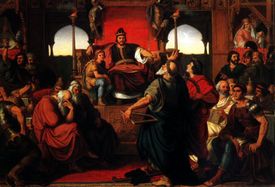
"When evening began to draw in, torches were lighted, and two barbarians came forward in front of Attila and sang songs which they had composed, hymning his victories and his great deeds in war. And the banqueters gazed at them, and some were rejoiced at the songs, others became excited at heart when they remembered the wars, but others broke into tears—those whose bodies were weakened by time and whose spirit was compelled to be at rest."
Attila demanded, as a condition of peace, that the Romans should continue paying tribute in gold—and evacuate a strip of land stretching three hundred miles east from Singidunum ( Belgrade) and up to a hundred miles south of the Danube. Negotiations continued between Roman and Hun for approximately three years. The historian Priscus was sent as emissary to Attila's encampment in 448, and the fragments of his reports preserved by Jordanes offer the best glimpse of Attila among his numerous wives, his Scythian fool, and his Moorish dwarf, impassive and unadorned amid the splendor of the courtiers:
- A luxurious meal, served on silver plate, had been made ready for us and the barbarian guests, but Attila ate nothing but meat on a wooden trencher. In everything else, too, he showed himself temperate; his cup was of wood, while to the guests were given goblets of gold and silver. His dress, too, was quite simple, affecting only to be clean. The sword he carried at his side, the latchets of his Scythian shoes, the bridle of his horse were not adorned, like those of the other Scythians, with gold or gems or anything costly.
"The floor of the room was covered with woollen mats for walking on," Priscus noted.
During these three years, according to a legend recounted by Jordanes, Attila discovered the "Sword of Mars":
- The historian Priscus says it was discovered under the following circumstances: "When a certain shepherd beheld one heifer of his flock limping and could find no cause for this wound, he anxiously followed the trail of blood and at length came to a sword it had unwittingly trampled while nibbling the grass. He dug it up and took it straight to Attila. He rejoiced at this gift and, being ambitious, thought he had been appointed ruler of the whole world, and that through the sword of Mars supremacy in all wars was assured to him.
- — Jordanes, The Origin and Deeds of the Goths ch. XXXV
Later scholarship would identify this legend as part of a pattern of sword worship common among the nomads of the Central Asian steppes.
Attila in the west
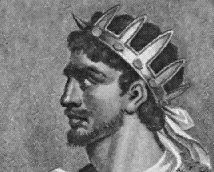
As late as 450, Attila had proclaimed his intent to attack the powerful Visigoth kingdom of Toulouse in alliance with Emperor Valentinian III. He had previously been on good terms with the western Roman Empire and its de facto ruler Flavius Aëtius—Aetius had spent a brief exile among the Huns in 433, and the troops Attila provided against the Goths and Bagaudae had helped earn him the largely honorary title of magister militum in the west. The gifts and diplomatic efforts of Geiseric, who opposed and feared the Visigoths, may also have influenced Attila's plans.
However Valentinian's sister Honoria, in order to escape her forced betrothal to a senator, had sent the Hunnish king a plea for help—and her ring—in the spring of 450. Though Honoria may not have intended a proposal of marriage, Attila chose to interpret her message as such; he accepted, asking for half of the western Empire as dowry. When Valentinian discovered the plan, only the influence of his mother Galla Placidia convinced him to exile, rather than kill, Honoria; he also wrote to Attila strenuously denying the legitimacy of the supposed marriage proposal. Attila, not convinced, sent an embassy to Ravenna to proclaim that Honoria was innocent, that the proposal had been legitimate, and that he would come to claim what was rightfully his.
Meanwhile, Theodosius having died in a horse riding accident, his successor Marcian cut off the Huns' tribute in late 450; and multiple invasions, by the Huns and by others, had left the Balkans with little to plunder. The king of the Salian Franks had died, and the succession struggle between his two sons drove a rift between Attila and Aetius: Attila supported the elder son, while Aetius supported the younger. J.B. Bury believes that Attila's intent, by the time he marched west, was to extend his kingdom—already the strongest on the continent—across Gaul to the Atlantic shore. By the time Attila had gathered his vassals— Gepids, Ostrogoths, Rugians, Scirians, Heruls, Thuringians, Alans, Burgundians, et al.—and begun his march west, he had declared intent of alliance both with the Visigoths and with the Romans.
In 451, his arrival in Belgica with an army exaggerated by Jordanes to half a million strong soon made his intent clear. On April 7, he captured Metz, and Aetius moved to oppose him, gathering troops from among the Franks, the Burgundians, and the Celts. A mission by Avitus, and Attila's continued westward advance, convinced the Visigoth king Theodoric I (Theodorid) to ally with the Romans. The combined armies reached Orleans ahead of Attila, thus checking and turning back the Hunnish advance. Aetius gave chase and caught the Huns at a place usually assumed to be near Châlons-en-Champagne. The two armies clashed in the Battle of Chalons, whose outcome commonly, though erroneously, is attributed to be a victory for the Gothic-Roman alliance. Theodoric was killed in the fighting. Aetius failed to press his advantage, according to Gibbon because he feared the consequences of an overwhelming Visogothic triumph as much as he did a defeat. From Aetius' point of view, the best outcome was what occurred: Theodoric dead, Attila in retreat and disarray, and the Romans having the benefit of appearing victorious. Thus the alliance quickly disbanded. Attila withdrew but returned to continue his campaign against Italy the following year.
Perhaps Sir Edward Creasy best summarized Aetius's intentions at the Battle of Chalons:
-
- It is probable that the crafty Aëtius was unwilling to be too victorious. He dreaded the glory which his allies the Visigoths had acquired, and feared that Rome might find a second Alaric in Prince Thorismund, who had signalized himself in the battle, and had been chosen on the field to succeed his father, Theodoric. He persuaded the young king to return at once to his capital, and thus relieved himself at the same time of the presence of a dangerous friend, as well as of a formidable though beaten foe.
Gibbon states the majority view also quite eloquently: "(Attila's) retreat across the Rhine confessed the last victory which was achieved in the name of the Western Roman Empire."
Invasion of Italy and death
Attila returned in 452 to claim his marriage to Honoria anew, invading and ravaging Italy along the way; his army sacked numerous cities and razed Aquileia completely, leaving no trace of it behind. Legend has it he built a castle on top of a hill north of Aquileia to watch the city burn - thus founding the town of Udine, where the castle can still be found. Valentinian fled from Ravenna to Rome; Aetius remained in the field but lacked the strength to offer battle. Gibbon however says Aetius never showed his greatness more clearly in managing to harass and slow Attila's advance with only a shadow force. Attila finally halted at the Po, where he met an embassy including the prefect Trigetius, the consul Aviennus, and Pope Leo I. After the meeting, he turned his army back, having claimed neither Honoria's hand nor the territories he desired.
Several explanations for his actions have been proffered. The plague and famine which coincided with his invasion may have caused his army to weaken, or the troops that Marcian sent across the Danube may have given him reason to retreat, or perhaps both. Priscus reports that superstitious fear of the fate of Alaric—who died shortly after sacking Rome in 410—gave the Hun pause. Prosper of Aquitaine's pious "fable which has been represented by the pencil of Raphael and the chisel of Algardi" (as Gibbon called it) says that the Pope, aided by Saint Peter and Saint Paul, convinced him to turn away from the city.
Whatever his reasons, Attila left Italy and returned to his palace across the Danube. From there, he planned to strike at Constantinople again and reclaim the tribute which Marcian had cut off. However, he died in the early months of 453; the conventional account, from Priscus, says that on the night after a feast celebrating his latest marriage to the beautiful and young Ildico (if uncorrupted, the name suggests a Germanic origin) he suffered a severe nosebleed and choked to death in a stupor. An alternative to the nosebleed theory is that he succumbed to internal bleeding after heavy drinking. His warriors, upon discovering his death, mourned him by cutting off their hair and gashing themselves with their swords so that, says Jordanes, "the greatest of all warriors should be mourned with no feminine lamentations and with no tears, but with the blood of men." His horsemen galloped in circles around the silken tent when Attila lay in state, singing in his dirge, according to Cassiodorus and Jordanes, "Who can rate this as death, when none believes it calls for vengeance?" then celebrating a strava over his burial place with great feasting. Legend says that he was laid to rest in a triple coffin—of gold, silver, and iron— along with some of the spoils of his conquests. His men diverted a section of the Duna, buried the coffin under the riverbed, and then were killed to keep the exact location a secret. After his death, he lived on as a legendary figure: the characters of Etzel in the Nibelungenlied and Atli in both the Volsunga saga and the Poetic Edda were both loosely based on his life.
An alternate story of his death, first recorded 80 years after the fact by the Roman chronicler Count Marcellinus, reports: "Attila rex Hunnorum Europae orbator provinciae noctu mulieris manu cultroque confoditur." ("Attila, King of the Huns and ravager of the provinces of Europe, was pierced by the hand and blade of his wife.") The Volsunga saga and the Poetic Edda claim that King Atli (Attila) died at the hands of his wife Gudrun. Most scholars reject these accounts as no more than romantic fables, preferring instead the version given by Attila's contemporary Priscus. The "official" account by Priscus, however, has recently come under renewed scrutiny by Michael A. Babcock. Based on detailed philological analysis, Babcock concludes that the account of natural death, given by Priscus, was an ecclesiastical "cover story" and that Emperor Marcian (who ruled the Eastern Roman Empire from 450-457) was the political force behind Attila's death.
His sons, Ellak (his appointed successor), Dengizich, and Ernakh, fought over the division of his legacy—"what warlike kings with their peoples should be apportioned to them by lot like a family estate" and, divided, were defeated and scattered the following year in the Battle of Nedao by the Gepids, under Ardaric, whose pride was stirred by being treated with his people like chattel, and the Ostrogoths. Attila's empire did not outlast him.
Medieval culture was full of rulers who boasted having a highest and mightiest ancestry. Attila the Hun, despite being from Asia and a conqueror ("barbarian") received his share of medieval dynasties whose clan legends maintain them to descend from Attila. One of the most credible claims have been the tsars of Bulgaria. Attila's many children and relatives are known by name and some even by deeds, but soon valid genealogical sources all but dry up, and there seems to be no verifiable way to trace Attila's descent. However, attempts have been made: Descent from Attila the Hun. Many genealogists attempted to reconstruct a valid line of descent from Attila to Charlemagne, but no one succeeded in working out a generally accepted route. See more at Attila the Hun to Charlemagne.
It should be noted that the founding of the famous city of Venice can be directly attributed to Attila and the Huns. The residents would flee to small islands in the Venetian Lagoon when Attila would invade Italy. The people eventually built a city there.
Appearance, character, and name
The main source for information on Attila is Priscus, a historian who traveled with Maximin on an embassy from Theodosius II in 448. He describes the village the nomadic Huns had built and settled down in as the size of the great city with solid wooden walls. He described Attila himself as:
"short of stature, with a broad chest and a large head; his eyes were small, his beard thin and sprinkled with gray; and he had a flat nose and a swarthy complexion, showing the evidences of his origin."
Attila's physical appearance was most likely that of an Eastern Asian or more specifically a Mongol-related ethnicity, or perhaps a mixture of this type and the Turkic (peoples of Central Asia). Indeed, he probably exhibited the characteristic Eastern Asian facial features, which Europeans were not used to seeing, and so they often described him in harsh terms.
Attila is known in Western history and tradition as the grim "Scourge of God", and his name has become a byword for cruelty and barbarism. Some of this may arise from a conflation of his traits, in the popular imagination, with those perceived in later steppe warlords such as the Mongol Genghis Khan and Tamerlane: all run together as cruel, clever, and sanguinary lovers of battle and pillage. The reality of his character may be more complex. The Huns of Attila's era had been mingling with Roman civilization for some time, largely through the Germanic foederati of the border—so that by the time of Theodosius's embassy in 448, Priscus could identify Hunnic, Gothic, and Latin as the three common languages of the horde. Priscus also recounts his meeting with an eastern Roman captive who had so fully assimilated into the Huns' way of life that he had no desire to return to his former country, and the Byzantine historian's description of Attila's humility and simplicity is unambiguous in its admiration.
The name Attila could be of pre- Turkic ( Altaic) origin (compare it with Atatürk and Alma-Ata, now called Almaty). It most probably originates from atta ("father") and il ("land"), meaning "Land-Father". Atil was also the Altaic name of the present-day Volga river which may have given its name to Attila. Attila is a frequently occuring name in the Hungarian and Turkish languages. Some experts say that Attila signifies "steel", "acél" (a-ts-ae-l) is the Hungarian word denoting "steel"; and this is phonetically similar to Attila.
Later literary representations
The historical context of Attila's life played a large part in determining his later public image: in the waning years of the western Empire, his conflicts with Aetius (often called the "last of the Romans") and the strangeness of his culture both helped dress him in the mask of the ferocious barbarian and enemy of civilization, as he has been portrayed in any number of films and other works of art.
In the Divine Comedy, he appears in the seventh circle of Hell, immersed in a river of boiling blood, and is called "the scourge of Earth". Dante also charges him with the destruction of Florence, but this is a blunder by the author, who has him confused with the Ostrogoth warlord Totila.
The Germanic epics in which he appears offer more nuanced depictions: he is both a noble and generous ally, as Etzel in the Nibelungenlied, and a cruel miser, as Ætla in Widsith,as Atli in the Volsunga Saga and the Poetic Edda. Some national histories, though, always portray him favorably; in Hungary and Turkey the names of Attila (sometimes as Atilla in Turkish), his last wife Ildikó and his brother Bleda remain popular to this day. In a similar vein, the Hungarian author Géza Gárdonyi's novel A láthatatlan ember (published in English as Slave of the Huns, and largely based on Priscus) offered a sympathetic portrait of Attila as a wise and beloved leader. And he is a powerfully dominant, extraordinarily charismatic figure in William Napier's ongoing trilogy, Attila, volume one appearing in 2005.
The British writer Anthony Burgess wrote a biographical novella about Attila entitled Hun which was published in the story collection The Devil's Mode.
